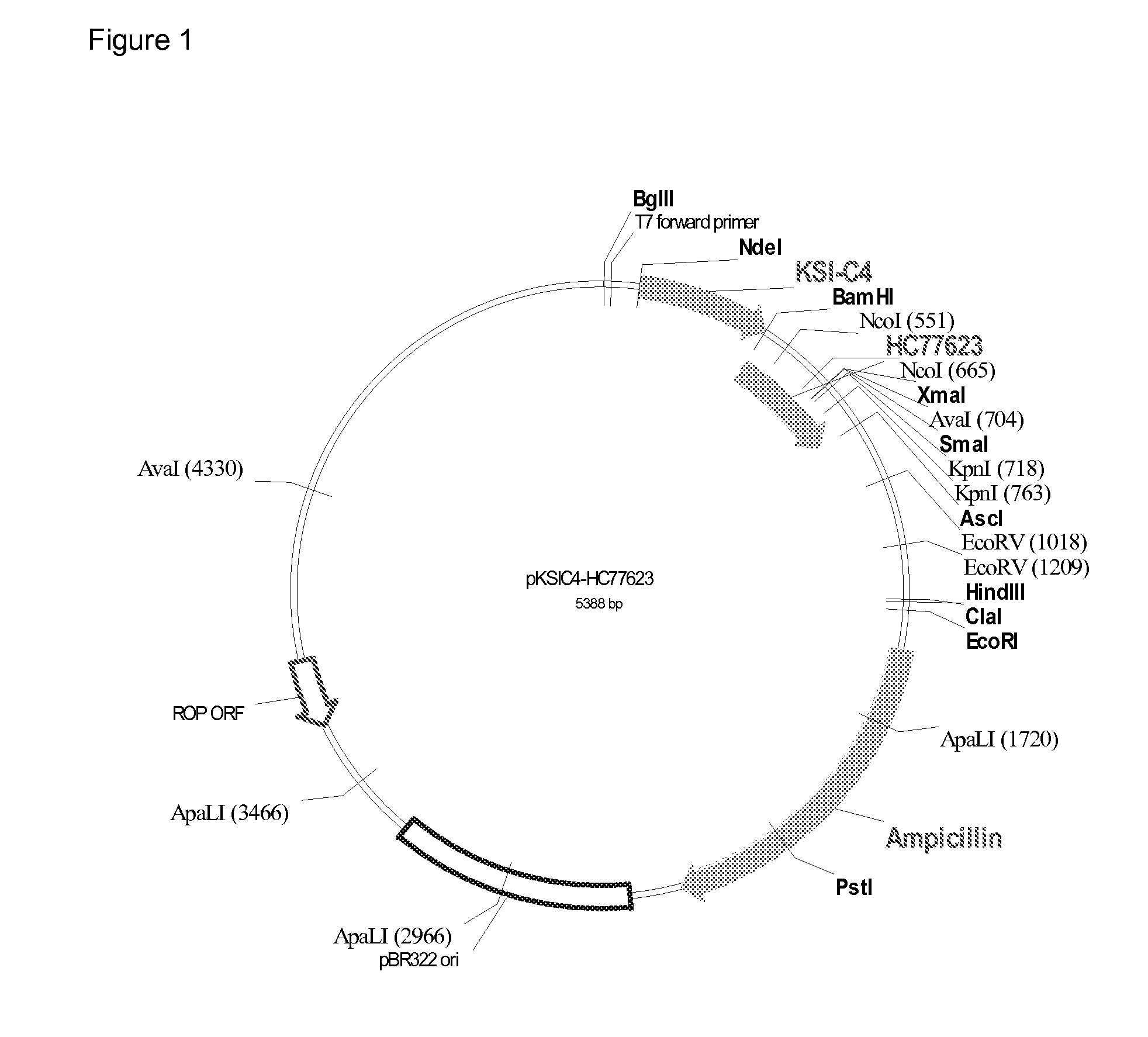Peptide-based hair protectants
a technology of hair protection and peptides, applied in the field of personal care products, can solve the problems of hair protection formed by coupling a hair-binding peptide to a sunscreen agent, hair protection agents with only a short-term effect, and weakened hair,
- Summary
- Abstract
- Description
- Claims
- Application Information
AI Technical Summary
Benefits of technology
Problems solved by technology
Method used
Image
Examples
example 1
Preparation of a Peptide-Based Hair Protectant
[0117]The purpose of this Example was to prepare a peptide-based hair protectant by covalently coupling a hair-binding peptide to the sunscreen agent cinnamic acid functionalized with acyl chloride.
[0118]Acyl chloride functionalized cinnamic acid (3-phenyl-2-propenoyl chloride, CAS No. 102-92-1, obtained from Aldrich; Milwaukee, Wis.), 18 mg, was dissolved in 5 mL of 1-methyl-2-pyrrolidone (NMP) and added to a solution containing 64 mg of trifluoroacetate salt of an unprotected hair-binding peptide having a sequence as SEQ ID NO:26 (obtained from SynBioSci, Livermore, Calif.), dissolved in 10 mL of NMP containing triethylamine (50 mg). The resulting solution was stirred at room temperature for 96 h. After that time, the solvent was removed by evaporation, yielding 95 mg of an orange, waxy solid.
[0119]The crude product was analyzed by gas chromatography-MALDI mass spectrometry and found to exhibit product molecular weights consistent with...
example 2
Preparation of a Peptide-Based Hair Protectant
[0120]The purpose of this Example was to prepare a peptide-based hair protectant by covalently coupling a multi-block hair-binding peptide to the sunscreen agent cinnamic acid functionalized with acyl chloride. The multi-block hair-binding peptide was prepared using recombinant DNA and molecular cloning techniques.
Biological Production of the Multi-Block Hair-Binding Peptide
[0121]The peptides were expressed in E. coli as inclusion bodies. Additional amino acid sequences (i.e., peptide tags) were fused to the multi-block hair-binding peptide sequence in order to promote inclusion body formation. Acid-labile Asp-Pro (DP) sequences were placed between the peptide tag and the multiple hair-binding peptide sequence to facilitate isolation of the multiple hair-binding peptide from the peptide tag.
Construction of Production Strains
[0122]The sequences of the multi-block hair-binding peptide is given in Table 2. DNA sequences were designed to enc...
example 3
Prophetic
Shampoo Composition Comprising a Peptide-Based Hair Protectant
[0135]The purpose of this prophetic Example is to describe how to prepare a shampoo composition comprising a peptide-based hair protectant.
[0136]The shampoo composition is prepared using the ingredients listed in Table 8.
TABLE 8Shampoo CompositionIngredientWt %Ammonium laureth sulfate12Sodium laureth sulfate5Di(hydrogenated) tallow phthalic acid4amideCocamide MEA2Polyquaternium-101Peptide-based hair protectant as7.5described in Example 1 or 2Citric acidto adjust pHDisodium EDTA0.5Fragrance0.7Waterqs to 100
[0137]The shampoo composition is prepared by combining water and the EDTA, heating to 65° C. and mixing until the EDTA is dissolved. Then the remaining ingredients are added, and the mixture is mixed until all the solids are dissolved and the color is uniform. The pH is adjusted with citric acid as desired.
PUM
| Property | Measurement | Unit |
|---|---|---|
| wavelength range | aaaaa | aaaaa |
| wavelength range | aaaaa | aaaaa |
| general structure | aaaaa | aaaaa |
Abstract
Description
Claims
Application Information
 Login to View More
Login to View More - R&D
- Intellectual Property
- Life Sciences
- Materials
- Tech Scout
- Unparalleled Data Quality
- Higher Quality Content
- 60% Fewer Hallucinations
Browse by: Latest US Patents, China's latest patents, Technical Efficacy Thesaurus, Application Domain, Technology Topic, Popular Technical Reports.
© 2025 PatSnap. All rights reserved.Legal|Privacy policy|Modern Slavery Act Transparency Statement|Sitemap|About US| Contact US: help@patsnap.com

